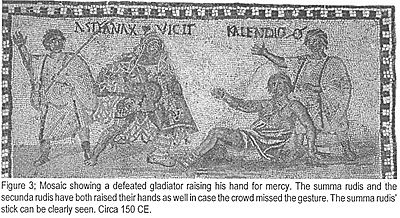
The introduction to the gladiatorial contests consisted of a beginning called the prolusio (or prelude). The various pairs would skirmish with wooden weapons, giving spectators a taste of their martial skills. This was to warm the fighters' muscles up physically while getting public into the mood to bet on favorite or a flashy new fighter. The anna lusoria (Lat. mock weapons) used for this part of the program are assumed to be the same type of wooden weapons or rudes as those in used in gladiatorial training.
Mosaic showing defeated gladiator raising his hand for mercy. The summa rudis and secunda rudis have both raised their hands as well in case the crowd missed the gesture. The summa rudis' stick can be clearly seen. Circa 150CE
After the prelude, the fighters retired and the probatio armorum took place before the audience. The weapons of 'sharp iron' (Lat. ferra acuta) were brought in and checked. Once this was completed to the editor's satisfaction the bouts were ready to begin.
The gladiators would come forth and fight each other in the pairings drawn up by the editor. In the compositio, (composition of the pairs,) usually it was best to match fighters of equal ability with each other. Tried and tested veterani (veterans) were infrequently matched against beginners (tirones) but some times there were exceptions. A talented and ambitious beginner could defeat a vet, we have inscriptions, especially from Pompeii, recording that fact.
It is assumed that each fighter's name and record was announced before the bout, but there is no proof.
There are praecones (heralds) mentioned in texts, but it would appear almost hopeless for a single announcer to be heard by spectators in the top layer of seats in a big amphitheater. Examples of composito tablets being used at the munua exist, another Pompeian tomb relief has an excellent example, but we are not sure of their exact function.
Gladiator must have been much like prize fighters today, using theatrics to gather attention, intimidate rivals, and become household names. We have many examples of graffiti, inscriptions, statues, frescoes dedicated to certain fighters. These had to be great and respected fighters throughout Rome and the provinces. Women were drawn to the sexual aspects produced by such a display of muscles, skill, sweat and blood. We are told that, like today's sports heros, known gladiators had large followings of groupies.
The mounted gladiators (Equites) always began a presentation, but they were not always present. There is no compelling evidence of this, but there seems to have been a set order of appearance for the other categories. It only made sense, Gladiators fought only in pairs, as the evidence has shown.
But the evidence also indicates that for special events and State commemorations the pairings might be increased. The story of Horatio holding back the Etruscan champions at the bridge in Rome's early history was often reenacted by a retiarius and two secutores, the retiarius holding the bridge against the secutores' advance. Large (gregatim) fights between whole stables of gladiators are mentioned in our sources, but they were held at very big munera, Such fights were probably portrayals of mythological or historical battles. The naumachiae (naval fight) would be staged on water, in biremes, usually on a lake.
However the athleticism of the gladiator in such occasions would be lacking, sheer spectacle replacing skill. Fighters in these events were usually captured enemies of Rome, or prisoners condemned to death
More History of the Munus Part 2 Gladiatorial Contests
-
Executing the Munus
The Preparation
Conduct of the Gladiatorial Contests
The Fight and Post Combat
Gladiators and Their Future
More History of the Munus Part 1 Gladiatorial Contests
-
Origins
The First Contests in Rome
The Games as a Political Tool
The Demise of the Munus
Ave Imperator: Gladiator Game Rules
Ave Imperator: Record Sheet
Re-enactor: Maximus the Lanista
Back to Strategikon Vol. 1 No. 4 Table of Contents
Back to Strategikon List of Issues
Back to MagWeb Master Magazine List
© Copyright 2001 by NMPI
This article appears in MagWeb (Magazine Web) on the Internet World Wide Web. Other military history articles and gaming articles are available at http://www.magweb.com